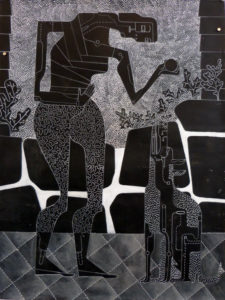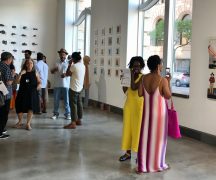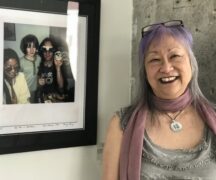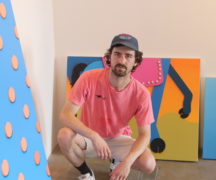By DAVID DUPONT
BG Independent News
Ancient myths tell us what the future holds for humanity.
That’s the underlining theme of artist K.A. Letts’ new show, Trans Human, at the River House Arts in the Secor Building in downtown Toledo.

“Good Dog” by K.A. Letts. (Image provided)
The exhibit opens with a reception tonight (Thursday, April 20) at 6 p.m. at the gallery at 425 Jefferson Ave. Regular gallery hours are Tuesday through Saturday, 4-10 p.m., and by appointment by calling 419-441-4025).
“I’m very interested in where we’re at as a species,” Letts said in a recent interview. “We’re at a point of being very close to the point of controlling our own evolution, and looking forward you wonder how the changes we make in ourselves will affect us as human beings.”
Bio-engineering, including gene therapy and neuro-prosthetics, and robotics which threaten to make much human work obsolete, pose existential questions about where humanity is headed.
One of the guides, Letts believes, “is through the stories we tell.”
So the artist takes stories either from Ovid’s Metamorphosis or the Bible and uses “them to discuss what human beings are and what we’re going to be.”
These are not illustrations, Letts said, “as much as making an image around the story.”
She translates her vision of those stories in to bold, graphic designs. Her work draws a number of influences. The Chicago imagist school played a key influence as did Matisse and aboriginal art.
She uses a limited palette. Black and white dominate. She uses silver and gold in a way that’s reminiscent of religious icons. Other tones are muted, and used sparingly.
In “Original Sin” there’s a rare use of red for the forbidden fruit. For Letts, the story of The Fall is the story of humans constantly pushing the limits. In the ancient stories whether Eve eating the forbidden fruit or Prometheus giving fire, or Icarus’ flying to close to the sun, this striving has “immediate consequences of catastrophe.”
But as Letts writes in her artist statement for the show: “It can be argued that without this endless thirst to do, be and know more, human beings wouldn’t be human at all. It is our defining characteristic.”
Satan in Letts’ vision is represented as a cyborg.
At the base of the tree words appear, but they are printer’s gibberish that serves “placeholder for knowledge that you don’t have.”
But pursuing this knowledge doesn’t mean humans are in control. Jonah is depicted in his large fish. He was, like other Old Testament prophets, “very hateful and recalcitrant.”
Jonah’s desires were “constantly thwarted.” That’s a common human condition. “We are moved along by circumstance no matter how much agency we think we’re exercising.”
Letts, who grew up in Kansas City, Kansas, took her own circuitous route to her mission.
She attended Barnard College in New York where she got a degree in history and studied art. While she wanted to be an artist, she decided to instead attend Yale Drama School to study set and costume design because that seemed a more secure career choice
“I thought that would be a way to scratch that itch without putting myself out there as an artist,” Letts said.
But after a half dozen years she realized that just wouldn’t do. “I wasn’t happy serving someone else’s vision.”
So taking her love of the human form and stories, she pursued art, first in Nova Scotia and later back in New York City. At that time she was focused on three-dimensional work. But she felt the stories that captivated her were better served in two dimensions.
In 1990 she moved to Ann Arbor with her husband Charles Letts III, whom she’d met at the Yale Drama School, so he could take over his family’s manufacturing business in the auto industry. Letts, 66, raised their two daughters.
In order to further her career she traveled to Chicago. Those visits became more frequent in 2008. To get established in a large market such as Chicago, she said, you need to be on the scene and make the rounds.
Letts also writes about art for Pulp, an online publication of the Ann Arbor Public Library and on her own blog site rustbeltarts.com.
The body of work in Trans Human started taking shape in 2010. “I feel very comfortable with this imagery,” she said. She was comfortable enough to start working in a larger scale. The River House show represents a step in that direction.
Her 18-foot-long interpretation of the muses in vinyl applique will be fastened on wall. They are a meditation on what the muses for contemporary humans would be. Maybe one for rap music. Maybe one for astrophysics. Letts leaves that an open question.
And while her work is in the first floor gallery, she’ll be painting a mural in a second floor hallway, a 75-foot stretch that takes people from the nearby parking garage into the building.
“You have to figure out what you’re saying then you can scale it up,” she said.
Finding that distinctive style of one’s own is “the most difficult task that any visual artist has. There’s so much visual incident everywhere now. It’s very difficult to make work that’s uniquely your own,” she said. “It took me awhile to get to it.”
The artist likened that search to “being in a cave, seeing opening, and seeing another opening, and you end up in being in a very personal space that’s yours.”





